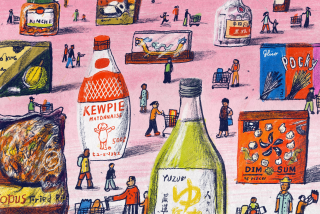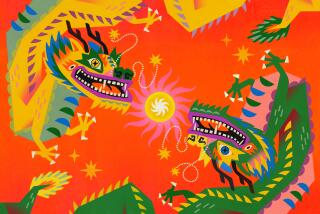A Coke and a Rat : Firm Hits National TV to Usher in the Chinese New Year, Boost Ethnic Share
- Share via
Marketers have long seized on the Chinese New Year as an occasion for drumming up business among the ethnic Chinese attending street celebrations in Los Angeles, San Francisco and other U.S. cities. This year Coca-Cola Co. is broadening its effort, ushering in the Year of the Rat with a national television spot, the first big marketer to do so.
The 30-second commercial, featuring a 44-foot dragon constructed from Coke cans, will air Monday during “Late Night With David Letterman” and the “Tonight Show With Jay Leno,” reaching a mainstream audience of young adults. Experts said the unusual spot should help build Coke’s image as a global thirst-quencher, besides reaching any ethnic Chinese up watching TV after a day of celebrating.
“It’s that ‘one drink, one world’ idea,” said Paul Sladkus, an ethnic-marketing consultant in New York. “They are emphasizing that they are a world leader and sensitive to the world’s cultures.”
He said the theme harks back to Coke’s “teach the world to sing” campaign from 1971, in which a multiethnic crowd gathered on a hilltop to celebrate global harmony and Coke.
In the lunar New Year spot, a drummer beats a traditional rhythm as the dragon sways through clouds of smoke, showing its 6,200 Coke cans to best advantage. The spot ends with a greeting in Chinese characters that means “We wish you prosperity.”
Certainly that is Coke’s wish for itself. Although Chinese Americans make up a small percentage of the nation’s population, they are among the brand’s most loyal customers. According to Sladkus, an estimated 64% of Chinese-speaking Americans drink Coke, and only 10% drink Pepsi. In the overall market, Coke and Pepsi are neck-and-neck.
The preferences of Chinese Americans in part reflect the popularity of Coke in their native countries. Coke is overwhelmingly the leading soft drink in Hong Kong and Taiwan, where it accounts for 92% of cola sales. According to U.S. census data, nearly a fifth of the 1.6 million Chinese Americans have arrived in the United States since 1980, many bringing with them a familiarity with Coke.
Besides airing the spot in the United States, Coke is running a dubbed version in six growing Asian markets on Monday: China, Hong Kong, Singapore, Taiwan, Thailand and Vietnam.
“It’s a way to join in a universally celebrated event,” said Coke spokesman Bob Bertini. “It reinforces the unity of the brand.”
The spot is Coke’s first built around an ethnic holiday. Until now, marketing around the lunar New Year or other ethnic events, such as the Cinco de Mayo celebration of the Mexican victory over invading French forces in 1862, has been confined to displays in local markets.
In general, big marketers rely on so-called grass-roots techniques to reach ethnic consumers. AT&T;, MCI and BankAmerica are among the companies planning to hawk their services at the Chinese New Year celebration in Los Angeles today. For example, MCI will be handing out traditional red envelopes stuffed with prepaid calling cards. Along with AT&T; and others, it is also promoting its services in the Chinese-language media.
Coke is doing some of those things as well. For instance, the company has placed signs in neighborhood grocery stores in the Los Angeles area that express New Year’s greetings in Chinese, Korean and Vietnamese.
With its TV spot, though, Coke is clearly aiming beyond ethnic Chinese consumers. Marketers could recall only one other advertiser that has used the Chinese New Year to reach the general market: Playboy magazine, in limited newspaper ads during the Year of the Rabbit.
They said Coke’s spot indicates that awareness of the lunar New Year has grown outside the Asian community. The holiday is covered by local media and heralded in Chinese restaurants.
Still, some marketers questioned Coke’s approach. Only people who can read Chinese will understand the greeting at the end of the commercial, they said.
“It could be nothing more than a gimmick, a way to get attention,” said David Chen, a specialist in ethnic marketing at the Los Angeles advertising agency of Muse Cordero Chen. “I’m sure the dragon made of Coke cans is visually attractive.”
In airing a spot that can be used internationally at a time when ad rates are relatively low, Coke isn’t risking much if the spot falls flat. As Chen points out, the spot can be reused in future years.
Whether other marketers will follow Coke’s lead remains to be seen. Few companies have the global reach of Coke. MCI said it has no plans for such a spot but applauds Coke’s move.
“It is a fun event, and Coke is making the association between it and fun,” said Rose Lee, ethnic marketing manager for MCI. “It’s a nice touch.”
(BEGIN TEXT OF INFOBOX / INFOGRAPHIC)
Brand Loyalty
Soft drink market-share estimates show that Chinese-speaking Americans are loyal Coke drinkers:
Coke: 64%
7-Up: 14%
Sprite: 11%
Pepsi: 10%
Others: 1%
Source: Paul Sladkus International Inc.
More to Read
Inside the business of entertainment
The Wide Shot brings you news, analysis and insights on everything from streaming wars to production — and what it all means for the future.
You may occasionally receive promotional content from the Los Angeles Times.









